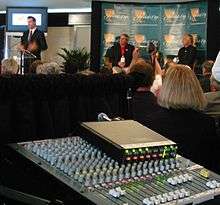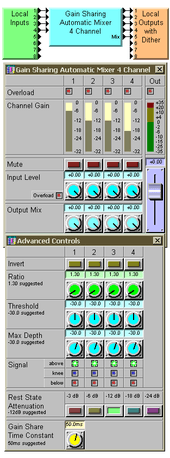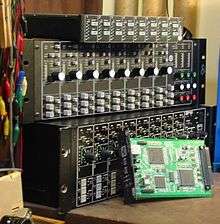Automixer

An automixer, or automatic microphone mixer, is a live sound mixing device that automatically reduces the strength of a microphone's audio signal when it is not being used. Automixers lower the hiss, rumble, reverberation and other extraneous noise that occur when several microphones operate simultaneously. They may also be used to mix sound from non-microphone signals such as playback devices.
Automixers are typically used to mix panel discussions on television talk shows and at conferences and seminars. They can also be used to mix actors' wireless microphones in theater productions and musicals. Automixers are frequently employed in settings where it is expected that a live sound operator will be not present, such as courtrooms and city council chambers.
Automixer hardware or software uses a variety of methods that allow increased gain before feedback for live sound reinforcement as well as reducing comb filtering between multiple microphones for recorded and broadcast applications.[1]
Use
Automixers balance multiple sound sources based on each source's level, quickly and dramatically adjusting the various signal levels automatically.[2] Automixers are used in live sound reinforcement to maintain a steady limit on the overall signal level of the microphones; if a public address system is set up so that one microphone will not feed back, then, in general, multiple microphones will not feed back if they are automixed. The equivalent number of open mics (NOM) present at the output of the automixer is kept low, regardless of the actual number of open mics.[3]
While a skilled audio mix operator can greatly enhance the performance of a sound reinforcement system he cannot anticipate with perfect accuracy which participant will speak next in a spontaneous discussion. Sudden interjections by panelists may be lost completely, or the beginning of a word may be absent (or upcut) because the operator does not respond quickly enough to "fade up" an audio signal.[4] A properly adjusted automixer can prevent losing words or phrases due to upcut mistakes or lapses of attention.[5]
Priority Ducking is used to lower the level of a microphone(s) and/or program material based on a source signal from another microphone, for the duration of the signal present at the source microphone. It restores the original level once the source signal has ceased. This is useful when a) program material needs to attenuate in order to accentuate the voice of a narrator, b) one microphone is used by a chairman or master of ceremonies, and needs to have priority over other mics and/or program material, or c) a paging mic must attenuate all other signals.
Automixers can be oriented toward live reinforcement application or permanent installation with varying degrees of connector type (XLR or block) and feature switches and channel potentiometers located internally or externally. Channel switches permit the user to vary sensitivity (dynamic mic, condenser mic, or line), phantom power, priority, and always on-or-auto mode ("on" being useful for uninterrupted music playback). Auto mixers are frequently configured in board rooms, but are also useful in theatrical and "town hall" events where several wireless microphones are in use. Auto mixers may be connected directly to wired mics and wireless mic receivers, or may be connected to the channel direct output or send jacks of a mixing console. Integration of an auto mixer with manual mixing console permits more precise input gain control, absolute mic muting, low cut filter, equalization and individual mic channel foldback control.
History
Frank J. Clement and Bell Labs received a patent in 1969 for a multiple station conference telephone system that switched its output to the loudest input.[6] The next year, Emil Torick and Richard G. Allen were granted a patent for an "Automatic Gain Control System with Noise Variable Threshold", an adaptive threshold circuit invention with its patent assignation going to Columbia Broadcasting System.[7]
Some systems using electro-mechanical switching in regard to microphone activation were engineered in the late 1960s and early 1970s. Peter W. Tappan and Robert F. Ancha devised a system of seat sensors that would activate one of 350 hidden microphones at the Seventeenth Church of Christ, Scientist in Chicago in 1970.[8] From approximately 1968, Ken Patterson and Diversified Concepts developed a hardware system that could detect the "Number of Open Microphones" (NOM) and attenuate the master output by an amount which increased with a higher number of microphones in use. This latter system was public domain.[9]
In 1971, Gregory Maston of Bell Labs filed for a patent involving a circuit that could switch between several audio sources based on their levels. The loudest one was latched into the mix. This system did not ramp switched signals smoothly in and out and did not maintain a constant ambience. It was intended for speakerphone conferencing applications.[10] In 1972, Keith A. T. Knox with the British Post Office Corporation developed an adaptive threshold gate circuit intended for speakerphone usage. The system used a second microphone somewhat near the first to sense ambient noise level.[11]

Dan Dugan showed his first "Adaptive Threshold Automatic Microphone Mixing System" in 1974 at the 49th Audio Engineering Society (AES) meeting in New York,[12] and was granted a patent for a control apparatus for sound reinforcement systems which sensed ambient sound level in the environment of a theater to control each microphone's individual level.[13] In 1976, Dugan was granted a patent for an automatic microphone mixing process whereby the total gain of the system remains constant.[14] He began manufacturing his first automixer system, the Model A, based on his two patents. Dugan built 60 units, with the first, hand-assembled one taken to Bell Labs to be installed in their conference room for Harvey Fletcher.[15] The algorithm was simple and effective: Each individual input channel is attenuated by an amount, in dB, equal to the difference, in dB, between that channel’s level and the sum of all channel levels.[16] Dugan licensed the system to Altec who released several automixer models including the 1674A, -B and -C series and the 1684A, all focusing on speech applications.[17][18] (The 1684A became an Electrovoice product and is currently administered by their Commercial division.[19]) The earliest Altec product implementation was regarded as inferior within the commercial audio contractor industry,[1] and other manufacturers began to design their own automixer products.
In 1978, Richard W. Peters of Industrial Research Products (IRP) was granted an improvement patent entitled "Priority mixer control".[20] IRP released the Voice-Matic series of 4 × 1 and 8 × 1 automatic mixers using "Dynamic Threshold Sensing" that weighed a combination of the amplitude and history of the signal to determine channel access. The master output was attenuated at the rate of 3 dB for every doubling of NOM.[21] This master output reduction was the solution used by Yamaha Pro Audio two decades later in their DME series of digital signal processing (DSP) products, incorporating an automixer function which was otherwise an 8- or 16-channel noise gate.[22]
Eugene Campbell and Terrance Whittemore of Colorado were granted a patent in 1982 for an automatic microphone mixing algorithm that allowed for musical performance mixing that would not be dominated by the loudest vocalist or instrumentalist.[23]

Stephen D. Julstrom of Shure Brothers, Inc. (Evanston, Illinois) was granted a patent in 1987 for a teleconferencing system that used special directionally gated microphones mixed automatically and sent to a distant party via telephone line. The return signal from the distant party was compared in strength to the local mix to determine which party was to be most prominent in the overall mix. Any interrupting party was given priority.[24] Four years later, Shure would introduce the AMS4000 and AMS8000 automixers for sound reinforcement; mixers which required the use of special directional condenser microphones of the Shure AMS Series.[25]
In 1985 Innovative Electronic Designs (IED) introduced the circuit card frame-based auto mic mixing system featuring combine-separate function and programmable gain control (PGC) modules. Combine-separate functionality is useful for ballroom applications with movable partitions that permit portions or all of a room to be used for one program or multiple programs. PGC modules compensate individual mic channel gain for soft-spoken or loud presenters, by slightly boosting or cutting channel gain, respectively. [26]
At the 87th AES Convention in 1989, Dugan introduced the idea of using an automixer inserted within target channels on a professional audio mixer. Each microphone's signal would be interrupted inside its channel strip and sent to a variable gain circuit contained within the automixer. The signal would then be returned to the mixer at a level consistent with the Dugan algorithm.[27] This became the Dugan Model D automixer.[28]
In 1991, Dugan's patent expired. Competing manufacturers began to bring the Dugan algorithm directly to their product designs. In 1993, Travis M. Sims, Jr. of Lectrosonics (Rio Rancho, New Mexico) was granted a patent for a sound system with rate controlled, variable attenuation of microphone inputs, including the Dugan algorithm as well as loudspeaker zone attenuation when in close proximity to an active microphone.[29] The loudspeaker zone part of the patent cited a 1985 patent for proportional amplification by Eugene R. Griffith, Jr. of LVW Systems of Colorado Springs, a commercial audio contractor.[30] In 1995, Sims and Lectrosonics gained another patent for an "Adaptive proportional gain audio mixing system" which incorporated a number of ideas including the Dugan algorithm for maintaining a constant total gain of all the inputs.[31]
In 1996, Dugan came out with the Model D-1, a speech-only economy model that did not offer the music system of the Model D.[15]
In 1997, John H. Roberts of Peavey Electronics was granted a patent for an automatic mixer priority circuit, enabling a hierarchy of logic weighting that allowed selected signals to push forward in the mix when they are in use, while still maintaining the useful constant unity, gain-sharing relationship first described by Dugan. The hierarchy enabled a host, moderator or chairperson to speak over other participants and retain control of the discussion.[32] Peavey's Architectural Acoustics division used three levels of hierarchy in their 1998 "Automix 2" product, placing the first- and second-most influentially weighted sources at inputs 1 and 2, respectively.[33]
Dan Dugan licensed his system to Protech Audio (Indian Lake, New York) in 1997, yielding the Protech 2000 model series.[34]
In 2004, the first standard audio mixer incorporating an eight-channel automixer section was released by Peavey in their Sanctuary Series,[35] and in 2006 the similar HP-W was introduced by Crest.[36] Both mixers were aimed at the House of Worship market, adding functions that ease the process of audio mixing to religious organizations.
In 2007, Mark W. Gilbert and Gregory H. Canfield of Shure (Niles, Illinois) were granted a patent for a digital microphone automixer system that used time of arrival as its main decision-making criteria.[37][38]

In February 2011, Dugan announced an automixer card to plug in the accessory slot of a Yamaha digital mixing console such as the LS-9, M7CL or PM-5D. This card, the Dugan-MY16, can mix 16 channels of microphone inputs at 44.1–48 kHz or 8 channels at 88.2–96 kHz sampling rates. Channels to be automixed are assigned in the mixer's graphic user interface, and can then be controlled by a common web browser interface affecting only the Dugan-MY16 card, allowing remote control with an iPad, touchscreen computer or laptop over wireless network.[39]
Related applications
- Speech intelligibility enhancement, James M. Kates of Signatron (1984). This system uses Dugan's automatic mixing algorithm to reconstitute several spectral regions of a signal that has been divided into frequency bands for short-time spectral analysis in order to achieve greater intelligibility of spoken consonants.[40]
- Secure conferencing, patent by Raoul E. Drapeau (1993). An automixing algorithm attempts to mask incidental speech that is below automix threshold but which can be audible in the mix. The automix circuitry indicates which sources are active, and whether masking of low-level signals is occurring.[41]
See also
References
- 1 2 Allan Soifer (May 2003). "Automatic Mic Mixers". Sound & Video Contractor. Retrieved 2011-03-12.
- ↑ "Rane Pro Audio Reference;". Rane. Retrieved 2011-03-12.
- ↑ Dan Dugan (January 1998). "The Right Mix: The applications of automatic microphone mixers are numerous and varied; know when and how to use them properly". Sound & Video Contractor. Retrieved 2011-03-12.
- ↑ "UPCUT". March 8, 2006. Retrieved 2011-03-12.
- ↑ Tom Stuckman, Steve Marks. "Automatic Mixers" (PDF). Retrieved 2011-03-12.
- ↑ US 3437758
- ↑ US 3496481
- ↑ US 3538254
- ↑ Dan Dugan (October 1989). "Application of Automatic Mixing Techniques to Audio Consoles". Audio Engineering Society. Retrieved 2011-03-12.
- ↑ US 3755625
- ↑ CA 893261
- ↑ Dugan, Daniel W. (February 1991). "Adaptive Threshold Automatic Microphone Mixing System Becomes Public Domain". Audio Engineering Society. Retrieved 2011-03-12.
- ↑ US patent 3814856, Dan Dugan, "Control Apparatus for Sound Reinforcement Systems", issued 1974-06-04
- ↑ US patent 3992584, Dan Dugan, "Automatic Microphone Mixer", issued 1976-11-16
- 1 2 Shannon Slaton (June 1, 2008). "Sound Product of the Month: Dugan Model E-1 Automatic Mixing Controller". Livedesignonline.com. Retrieved 2011-03-12.
- ↑ "The Path Less Taken – Dugan Automixing" (PDF). Protech Audio. Retrieved 2011-03-12.
- ↑ "1674C & 1678C Automatic Microphone Mixers". Retrieved 2011-03-12.
- ↑ "1684A Expandable Automatic Microphone Mixer". Retrieved 2011-03-12.
- ↑ Electrovoice Commercial. 1684A Expandable Automatic Microphone Mixer
- ↑ US 4149032
- ↑ "Automatic Mixers Voice-Matic". Industrial Research Products. Retrieved 2011-03-12.
- ↑ "DME Designer Owner's Manual, version 3.5" (PDF). Yamaha Pro Audio. 2004. pp. 421–424. Retrieved June 25, 2010.
- ↑ US 4357492
- ↑ US 4712231
- ↑ AMS4000 and AMS8000 Installer's Manual (PDF), Shure, retrieved 2015-04-02
- ↑ "IED History". Retrieved 2015-02-27.
- ↑ Dan Dugan (October 1989). "Application of Automatic Mixing Techniques to Audio Consoles". Audio Engineering Society. Retrieved 2011-03-12.
- ↑ Dan Dugan Sound Design. Model D Archived August 29, 2009 at the Wayback Machine
- ↑ US 5204908
- ↑ US 4598418
- ↑ US 5414776
- ↑ US 5652800
- ↑ "Automix 2" (PDF). Retrieved 2011-03-12.
- ↑ "Dugan Automixers – The World's Best Automixers". Protech Audio. Retrieved 2011-03-12.
- ↑ Peavey.com Peavey Innovations Timeline Archived September 14, 2008 at the Wayback Machine
- ↑ "Crest Audio Introduces The HP-W Professional Mixing Console". Harmony Central. July 15, 2006. Archived from the original on May 16, 2008.
- ↑ US 20070191977, "Digital Microphone Automixer"
- ↑ WIPO. "World Intellectual Property Organization. ''(WO/2007/090010) A DIGITAL MICROPHONE AUTOMIXER''". Wipo.int. Retrieved 2011-03-12.
- ↑ "Dan Dugan Sound Design". National Association of Broadcasters. Retrieved March 21, 2011.
- ↑ US 4454609
- ↑ US 5197098
External links
- "Technology Showcase: Automatic Microphone Mixers" May 2007. Sound & Video Contractor. Bennett Liles.